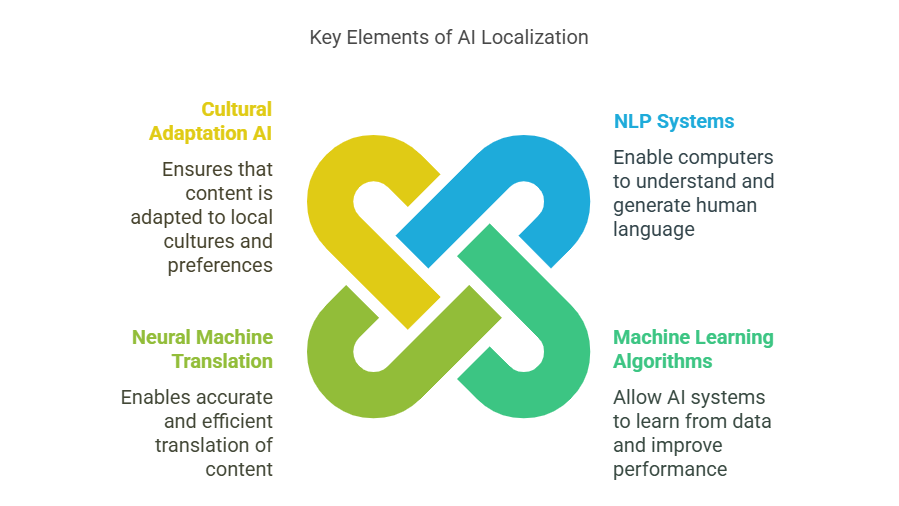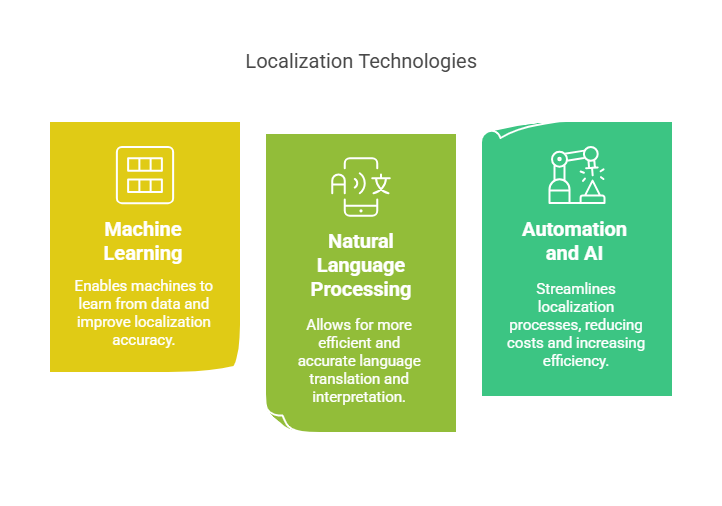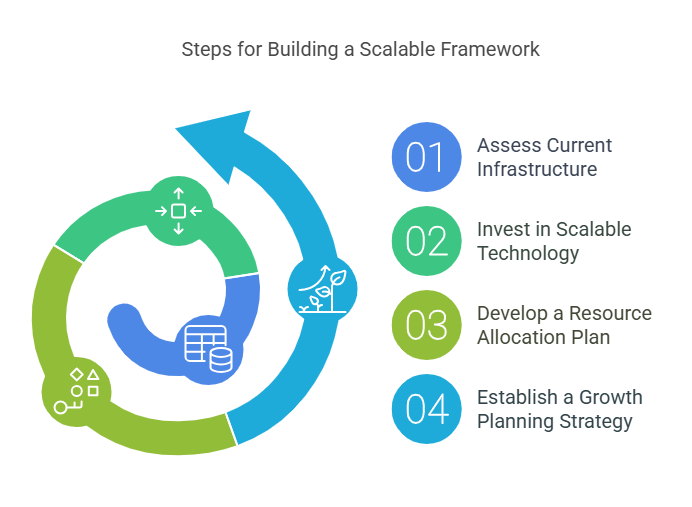Businesses want to grow worldwide but face a big challenge. They need to talk to people in many languages and cultures. AI localization helps by making content fit local needs.
This way, companies can grow globally and be strong in new markets. AI localization makes it easier to connect with people everywhere.
With AI localization, businesses can make content that speaks to people all over. This makes customers feel closer and helps businesses grow. It also keeps them ahead in the global market.
Understanding AI Localization in Today’s Global Market
Businesses going global face a big challenge. They need to talk to many different people. AI localization helps by making content fit for each area. It’s better than old ways because it uses new tech.
Old ways of localizing are changing fast. New tech like machine learning and natural language processing help a lot. These tools make localizing content faster and cheaper. Now, AI localization is key for companies wanting to reach out to people all over.
Key Components of AI Localization
- Natural Language Processing (NLP) systems
- Machine Learning algorithms
- Neural Machine Translation
Businesses use these parts to make a strong AI localization plan. They can change product descriptions, translate websites, and make ads that fit each culture. AI localization changes how companies grow globally. It helps them talk to people from all over, breaking down language and culture barriers.
| Technology | Description |
|---|---|
| NLP | Enables computers to understand and process human language |
| Machine Learning | Allows systems to learn from data and improve performance over time |
| Neural Machine Translation | Facilitates accurate and efficient translation of text and speech |
The Business Case for AI-Powered Language Solutions
Businesses growing into new markets face a big challenge. They need to talk to different people well. AI powered language solutions help a lot. They make things more efficient, cheaper, and better for customers.
AI powered language solutions bring many good things. For example, they help companies:
- Automate language translation, cutting down on errors
- Quickly understand what customers think, making things better fast
- Make content and ads just right for each place and language, making customers happier
Using AI powered language solutions makes a strong case for growing globally. This can lead to more money, a better brand, and being more competitive worldwide.
| Benefits | Description |
|---|---|
| Increased Efficiency | Automation of language translation and analysis |
| Reduced Costs | Less need for human translators and fewer mistakes |
| Improved Customer Engagement | Content and ads tailored to each place and language |
Core Components of Modern AI Localization
AI localization is a complex process. It involves many parts working together. These parts are natural language processing (NLP) systems, machine learning algorithms, neural machine translation, and cultural adaptation AI.
NLP systems are key. They let computers understand and make human language. Machine learning algorithms help AI systems get better over time.
By using NLP and machine learning together, AI localization gets very good at its job. Here are some important parts:
- NLP systems: enable computers to understand and generate human language
- Machine learning algorithms: allow AI systems to learn from data and improve performance
- Neural machine translation: enables accurate and efficient translation of content
- Cultural adaptation AI: ensures that content is adapted to local cultures and preferences
These parts work together to make content fit for different markets. This way, businesses can reach more people and make customers happier.
| Core Component | Description |
|---|---|
| NLP Systems | Enable computers to understand and generate human language |
| Machine Learning Algorithms | Allow AI systems to learn from data and improve performance |
| Neural Machine Translation | Enables accurate and efficient translation of content |
| Cultural Adaptation AI | Ensures that content is adapted to local cultures and preferences |

How AI Localization Transforms Customer Experience
AI localization changes how businesses talk to people all over the world. It lets them share content that really speaks to people from different places. This way, companies can understand what their customers like and want, making them happier and more loyal.
AI localization has many benefits for customers. For example, it helps businesses:
- Share content that fits local needs and tastes
- Offer help in many languages, so customers can talk to the brand in their own tongue
- Look at what customers say and feel right away, so they can answer quickly
Using AI localization makes customer experiences better. As customer experience is key in today’s world, AI localization is a must for companies wanting to connect with people everywhere. It helps make sure the brand’s message is clear and strong, no matter where it goes.
As companies grow globally, AI localization will become even more important. By using AI localization, businesses can keep up with changing customer needs. They can give amazing experiences that meet what customers want now.
Implementation Strategies for Successful AI Localization
Businesses need to plan well for AI localization. This means looking at many things like planning, checking things out, and using new tech. Good plans help make AI localization work well.
The first step is to check and plan. This means looking at how things are now and finding ways to get better. Assessment is key here. It helps companies know what they need and make a plan just for them.
Key Implementation Steps
- Conduct a thorough assessment of current localization processes
- Develop a customized implementation plan
- Integrate AI-powered technology solutions
- Provide team training and support
Choosing the right tech is also very important. Companies need to pick the best AI tools for their needs. This could be things like learning machines and language systems. These tools help make localization better, faster, and cheaper.
| Implementation Phase | Key Activities | Benefits |
|---|---|---|
| Assessment and Planning | Evaluation of current processes, development of implementation plan | Improved understanding of localization needs, tailored implementation strategy |
| Technology Integration | Selection and integration of AI-powered tools and platforms | Enhanced localization efficiency, reduced costs, improved quality |
| Team Training and Support | Training and support for personnel involved in localization processes | Improved team productivity, reduced errors, enhanced overall localization quality |
Measuring ROI and Performance Metrics
To check if AI localization works, we need to look at measuring roi and performance metrics. We track important signs that show how AI localization helps a business. These signs are translation quality, how customers interact, and how much money is made.
By looking at these performance metrics, companies can learn a lot. They can see if their AI localization is doing well. This helps them make their strategies better, improve how customers feel, and make more money. For example, a company can see where their translation is not good and fix it.
Some important performance metrics to think about when checking AI localization are:
- How good the translations are
- How customers interact, like clicks and sales
- How much money is made and the return on investment (ROI)
- How happy customers are
By often measuring roi and watching these performance metrics, companies can make their AI localization better. As AI localization gets better, it’s key for companies to keep an eye on measuring roi and performance metrics. This way, they can make the most of their efforts.
Common Challenges and Strategic Solutions
Businesses face many challenges when using AI for localization. These include technical issues, making sure quality is high, and managing costs. It’s key to know these challenges and find ways to solve them.
Technical integration is a big worry. It means making sure AI works well with current systems. Quality is also important, as it means the content is right and error-free. And, managing costs is hard, as it’s about balancing spending on AI with the benefits of reaching new markets.
Technical Integration Issues
To solve technical issues, first check your systems. Then, plan how to make AI work with them. You can also work with tech experts to help.
- Conduct thorough system audits
- Develop customized integration plans
- Collaborate with technical experts
Quality Assurance Processes
Quality is key for making sure content is good. To do this, test a lot and check quality often. You can also use AI to find mistakes.
- Implement rigorous testing protocols
- Conduct regular quality audits
- Use machine learning to find errors
| Challenge | Solution |
|---|---|
| Technical Integration | Do system audits and make plans for integration |
| Quality Assurance | Test a lot and check quality often |
| Cost Management | Plan costs well and watch spending |
Future Trends in AI Localization Technology
AI localization is changing fast. It’s key to keep up with new trends. Technologies like machine learning and natural language processing will be big. They will help businesses grow worldwide.
The future of AI localization looks bright. It will be more efficient, accurate, and personal. Businesses will offer better experiences to customers everywhere.
New trends mean big chances for businesses. They can reach more people and connect better with customers. By using new tech, companies can grow and stay ahead.
| Trend | Description |
|---|---|
| Machine Learning | Enables machines to learn from data and improve localization accuracy |
| Natural Language Processing | Allows for more efficient and accurate language translation and interpretation |
| Automation and AI | Streamlines localization processes, reducing costs and increasing efficiency |

Best Practices for Global Content Strategy
Creating a great global content strategy means knowing local markets well. It’s about making content that fits each culture. Best practices use AI to make content personal and local for everyone. This helps businesses connect better, get more people involved, and grow.
Doing good market research is key. It helps find out what people like and what’s important in each place. This way, content can really speak to the audience, making the brand strong in local areas.
Important things to think about include:
- Localizing content for different places and languages
- Making content that fits local customs and traditions
- Using AI to make content more personal and better
Using these best practices helps businesses make great content. This leads to success in local markets and a strong global presence. A good global content strategy is vital for growing and reaching out to people all over the world. By following these tips, companies can make content that really speaks to their global audience, fitting their global content strategy.
| Strategy | Description |
|---|---|
| Market Research | Conduct thorough market research and analysis to inform content creation |
| Content Localization | Localize content to meet the needs of specific regions and languages |
| Cultural Relevance | Create culturally relevant content that takes into account local customs and traditions |
Building a Scalable AI Localization Framework
To make AI localization work, businesses need a plan that grows with them. They must think about what they need now and in the future. This includes planning for infrastructure, resources, and how to grow.
A good plan helps manage costs and improves quality. It lets companies handle more work without spending too much.
When making a plan, think about what you need to grow. You’ll need strong technology and tools. These should handle more data and work as you get bigger.
Key Considerations for a Scalable Framework
- Assessing current infrastructure and identifying areas for improvement
- Investing in scalable technology and tools
- Developing a resource allocation plan that supports growth
- Establishing a growth planning strategy that aligns with business objectives
By focusing on these points, businesses can make a plan that grows with them. A good plan helps manage work, improves quality, and saves money. This lets companies reach more customers and succeed globally.
| Infrastructure Requirements | Resource Allocation | Growth Planning |
|---|---|---|
| Scalable technology and tools | Skilled personnel and training | Business objectives and market analysis |
| Robust data management systems | Financial resources and budgeting | Market trends and competitor analysis |

Conclusion
AI localization is a game-changer for businesses. It helps them grow globally and connect with people everywhere. With AI, companies can break down language and cultural barriers.
This means they can offer experiences that really speak to their customers. It’s all about making a personal connection with people all over the world.
AI localization brings many benefits. It makes customer interactions better and content more engaging. It also makes work easier and saves money.
By using AI localization, companies can stand out in a crowded market. They can prepare for the future and stay ahead. It’s a smart move for any business looking to grow globally.
The future of localization is exciting. New technologies and trends will shape how we connect globally. Now is the time for businesses to use AI localization to their advantage.
This way, they can build strong relationships with customers worldwide. They can handle the challenges of the global market with ease and confidence.
Frequently Asked Questions
What is AI localization?
AI localization uses artificial intelligence to make content fit for different languages and cultures. It’s more than just translating. It uses AI to make content that speaks to people all over the world.
How does AI localization differ from traditional localization methods?
Old ways of localization are slow and hard work. AI localization uses smart tech to make it fast and easy. This makes adapting content cheaper and more accurate.
What are the key technologies driving AI localization?
Key tech for AI localization includes natural language processing and machine learning. Also, neural machine translation and cultural adaptation AI are important. These tools help make content fit for local tastes and cultures.
How can AI localization transform the customer experience?
AI localization lets businesses give content that feels personal to their audience. It knows what customers like and what they’re into. This makes customers happier and more loyal.
What are the common challenges in implementing AI localization?
Challenges include getting tech to work right, checking quality, and keeping costs down. To solve these, businesses need good plans, tech setup, and training for teams.
What are the future trends in AI localization technology?
The future will bring new tech like better AI and machine learning. These will make localization even better and more personal. This opens up new chances for businesses to reach more people worldwide.
How can businesses build a scalable AI localization framework?
To grow, businesses need to think about their setup, resources, and plans. They should build a system that can grow with them. This means making a flexible and adaptable framework.

